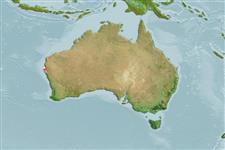Environment: milieu / climate zone / depth range / distribution range
Ökologie
seewasser demersal. Tropical; 25°S - 26°S
Eastern Indian Ocean: known only from Shark Bay, Western Australia.
Size / Gewicht / Alter
Maturity: Lm ? range ? - ? cm
Ventral surface of lower jaw covered with numerous prickles or papillose villi and with cirri on both inner and outer margins. Isthmus with fleshy pad, its width about 1/4-1/3 of its length (Ref. 39602).
Found inshore, in soft bottom.
Life cycle and mating behavior
Geschlechtsreife | Fortpflanzung | Ablaichen | Eier | Fecundity | Larven
Paxton, J.R., D.F. Hoese, G.R. Allen and J.E. Hanley, 1989. Pisces. Petromyzontidae to Carangidae. Zoological Catalogue of Australia, Vol. 7. Australian Government Publishing Service, Canberra, 665 p. (Ref. 7300)
IUCN Rote Liste Status (Ref. 130435: Version 2024-2)
Bedrohung für Menschen
Harmless
Nutzung durch Menschen
Tools
Zusatzinformationen
Download XML
Internet Quellen
Estimates based on models
Preferred temperature (Ref.
123201): 23.1 - 23.8, mean 23.5 °C (based on 8 cells).
Phylogenetic diversity index (Ref.
82804): PD
50 = 0.5078 [Uniqueness, from 0.5 = low to 2.0 = high].
Bayesian length-weight: a=0.00537 (0.00215 - 0.01342), b=3.14 (2.92 - 3.36), in cm total length, based on LWR estimates for this (Sub)family-body shape (Ref.
93245).
Trophic level (Ref.
69278): 3.4 ±0.3 se; based on size and trophs of closest relatives
Fishing Vulnerability (Ref.
59153): Low vulnerability (10 of 100).
